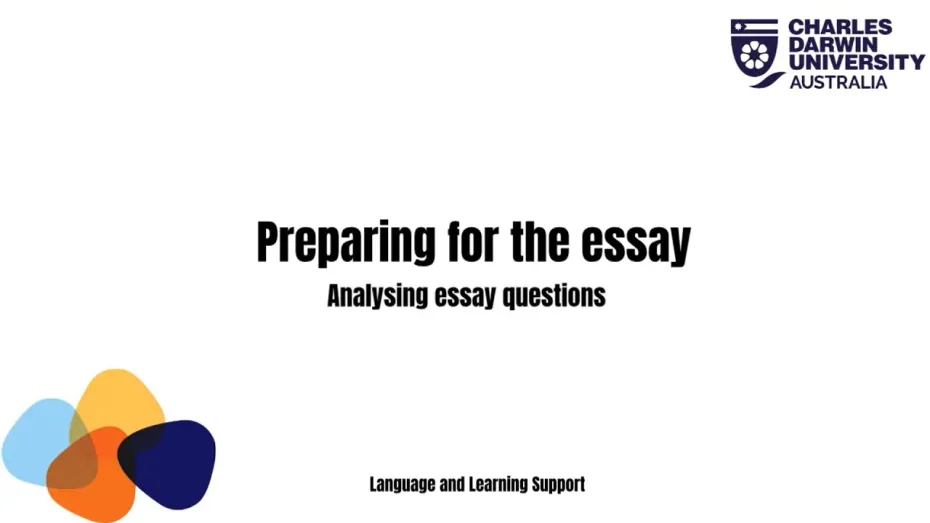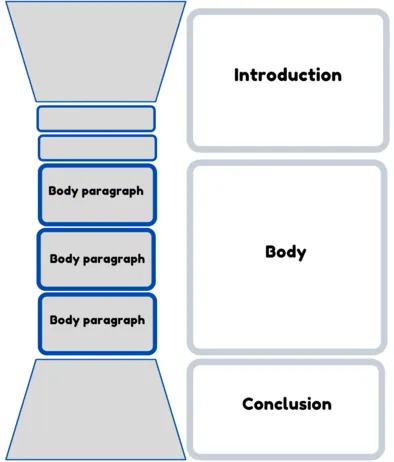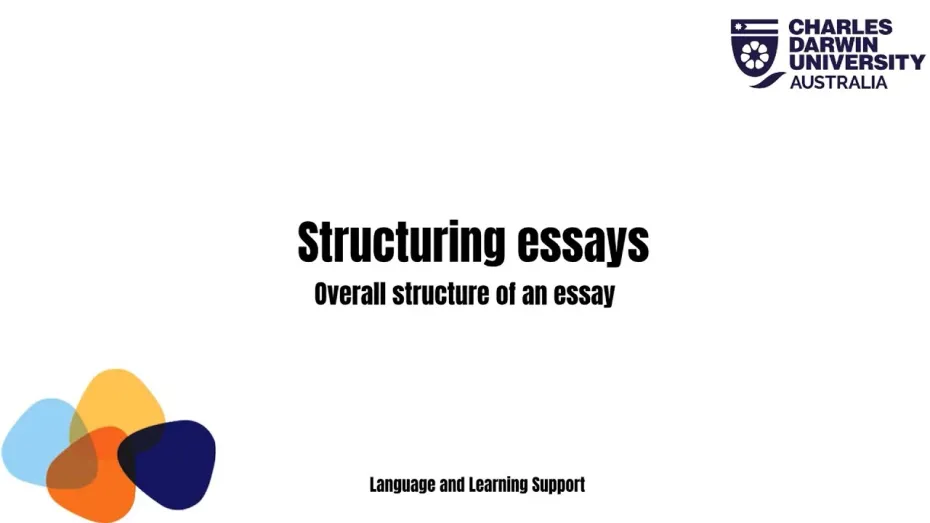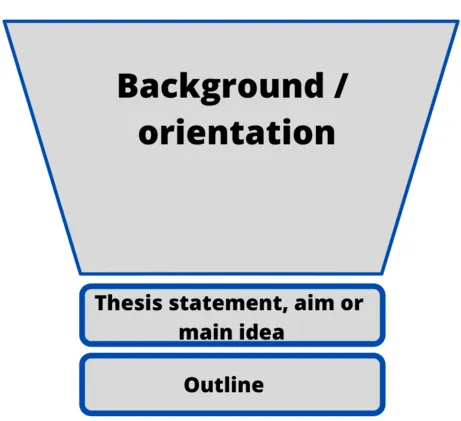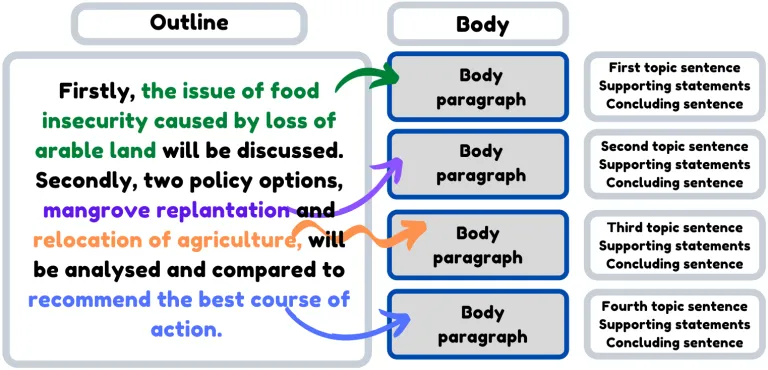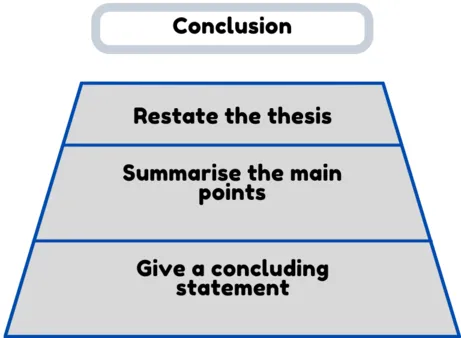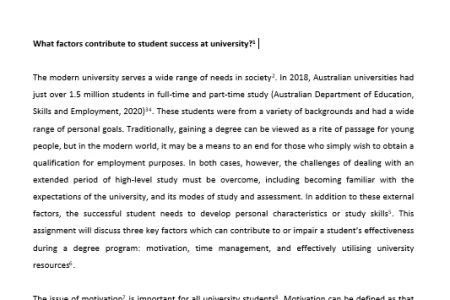Essays are common assessment tasks in some university faculties. They have been defined as 'a short piece of writing on a particular subject, especially one done by students as part of the work for a course' (Cambridge Dictionary, n.d.). This definition may seem vague, so this page will help you to meet your lecturers' expectations by:
- self-evaluating your current strengths and weaknesses
- understanding the purpose and features of essays
- analysing essay questions to better understand task requirements
- creating well-structured and coherent essays.
Download this summary sheet for your own reference.
Introduction to essays
This section gives you a general overview of essays and helps you evaluate your own skills.
Self evaluation
Reflect on your previous writing experience and feedback you have received. How would you rate your ability in the following essay writing skills? Rate your ability from ‘good’ to ‘needs development’.
If you feel confident about your skills, you may find it helpful to review the materials on this page to confirm your knowledge and possibly learn more. Don't worry if you don't feel confident. Work through these materials to build your skills.
Features of strong essays
A well-written essay will:
- answer all elements of the essay question
be well-structured and coherent
present a strong argument
use reliable evidence to support your arguments
be written in appropriate academic style.
Whatever the essay question, you should consider the following questions.
- Who is the (imaginary) reader of this essay?
- What is the purpose of this essay?
- How will I organise the points in the body to achieve this purpose?
In previous studies, you may have learned about different types of essay, such as discursive or argumentative, cause and effect, problem-solution, or compare and contrast. In fact, these are not really different types of essays. These are just different ways you may organise the content in the body of your essay to achieve the purpose. Many university writing tasks include more than one of these types. For instance, you may need to write an argumentive text, and in doing so, you may compare and contrast different theories. That means you must prepare by analysing the task or essay question carefully.
Preparing for the essay
Before you begin working on an essay, you must understand what you are being asked to discuss. So, you must start by analysing the essay question carefully.
Analysing essay questions
Read this essay question and watch the video to learn more.
Fetal alcohol spectrum disorder can cause childhood cognitive impairment, leading to a lifetime of disadvantage. Evaluate the role of the national government in addressing this issue in remote communities.
Analysing essay questions: putting it to practice
Consider what you learned in the video and analyse two essay questions.
- Identify the task words, topic words and focus words.
- Click on the icons to check your answers.
Understanding essay task words
Some task words are used frequently in essay questions. You should ensure you understand what they all mean.
Drag the best definition underneath each task word.
Applying your learning
Apply what you have learned to your own assessments.
Go to your units on Learnline.
Find and analyse your own essay questions.
Discuss your ideas with your peers.
Analysing your topic will help you with the next steps. You may:
- visit the library guides for advice on research in your discipline
- visit the Study Skills page research, reading, note-taking for advice on effective reading strategies.
Structuring your essays
After analysing the question, researching, note-taking and planning, you are ready to write your first draft. To do this, you will follow the standard three-part structure of a university essay: introduction, body and conclusion.
- Work through this material to help you understand the structure.
- Use this Essay Mapping Tool to help you use the structure.
Organising the essay 1
This section will explain how essays are organised. Most university essays follow a standard three-part structure: introduction, body and conclusion. These are divided into paragraphs.
In some disciplines, you may use headings in your essay. If your lecturer requires this, you can visit the Cohesion page to learn more about writing effective headings.
Most disciplines do not require headings in the body of the essay. Therefore, you must organise your essay very carefully.
Organising the essay 2
Watch this video to learn more about the standard three-part structure of essays.
Check your understanding by identifying the elements that usually appear in each of the three parts of a standard essay.
Writing a strong introduction
This section will help you to write strong, well-structured introductions.
The elements of a strong introduction
An introduction should include the following:
| Background | The background sets the context by giving background information that shows the importance of the topic or justifies your research. |
| Thesis statement | Your thesis statement outlines your main aim, purpose or argument. |
| Outline | The outline identifies the main topics and sub-topics. It tells your reader how your paper will be organised. |
| Scope | The introduction may include a scope if the topic is broad and you need to narrow it down. |
Read the example introduction for the essay on fetal alcohol disorder.
- Can you recognise each element?
- Click on the hotspots to check your ideas.
Applying your learning
It’s your turn. Analyse the introduction about student success at university.
Read the following sentences from the essay question about Kiribati. Put them in order to create a cohesive introduction.
Writing a strong body
This section will help you to write a well-structured body for your essay. In addition, remember that a strong essay must:
- be cohesive
- have strong, accurate sentences
- be written in an academic style
- use appropriate discipline vocabulary
- support your points with evidence from the experts.
The organisation of a strong essay body
The body of the essay is divided into paragraphs that present ideas that support the thesis statement. Each paragraph will focus on one main idea. Each will also include a topic sentence, supporting evidence, and possibly a link or concluding sentence.
Paragraphs will present ideas in the same order as the outline in the introduction. For example, the Kiribati essay may present ideas in this order:
The elements of paragraphs
The body of your essay is made up of well-constructed paragraphs. Just like your essays all follow a three-part structure, many (although not all) paragraphs also have a three-part structure. This is known as TEEL/C.
| T | means topic sentence. |
| E | means explanation, elaboration, evidence or example. |
| L/C | means link or conclusion (optional) |
Visit Paragraphs to learn more about these elements.
Writing a strong conclusion
This section will help you to write strong, well-structured conclusions.
The elements of a strong conclusion
Conclusions can be the weakest part of student essays because they are often written last when students are tired. However, your conclusions are very important because they are your chance to reinforce your ideas and end strongly. To ensure you write a strong conclusion, you should:
take a break before you write your conclusion
reread your introduction focusing on your thesis and outline
ensure your introduction and conclusion are aligned.
The conclusion should:
restate your thesis or the main idea of the paper
give a summary of the issues covered in the essay
make a concluding statement.
Remember: no new information is usually included in your conclusion.
Applying your learning
Read this example conclusion. Compare it with the introduction from the same essay. Can you find the paraphrase of the thesis statement?
It’s your turn. Identify the different sections of the conclusion to the essay on student success at university.
Read the following sentences from the essay question about Kiribati. Put them in order to create a cohesive conclusion.
Now, analyse the conclusion to identify the stages.
Essay writing and generative AI
The ethical use of generative AI (GenAI) for essay writing at university hinges on maintaining academic integrity and originality. While GenAI can be a valuable tool for brainstorming ideas, generating outlines, and enhancing the writing process, students must ensure that the work they submit is authentically their own. Relying excessively on AI-generated content can undermine the learning process and violate academic honesty policies.
The limitations of GenAI for essay writing
Generative AI (GenAI) for essay writing has several limitations, including a lack of deep understanding, potential issues with originality and plagiarism, and challenges in maintaining contextual relevance. Ethical concerns arise from over-reliance on AI, potentially undermining academic integrity. The quality of AI-generated text can be inconsistent, and there is a risk of perpetuating biases present in the training data. Additionally, GenAI lacks true creativity, producing content that may be coherent but not genuinely novel, and excessive use can hinder the development of students' own writing and critical thinking skills.
Have a look at the essay task below, its marking rubric, and the sample provided. Do you think the sample addresses the task requirements and the elements in the rubric?
Now answer questions 1-5 below.
Click on the hotspots below to see all the issues with the AI-generated essay. Then compare it with a sample written by a student.
Reading the AI-generated essay, it is impossible to draw an elaborated and well-established position, which an essay should be about. The essay seems to linger on comparisons between two perspectives, and although at one point the writer appears to suggest that the way people look at art is just lagging behind, this needs to be made more explicit. In addition, there is no reflection on the thought process of the writer, which is clearly required in the assignment task.
Prompts to help you get started with your essay
Prompt engineering is a pivotal skill in leveraging AI effectively for academic and professional purposes. Clear and specific prompts, such as those focusing on outlines or research plans rather than final products, foster deeper engagement with the subject matter and uphold academic integrity.
See below some prompts to help you get started with your next essay.
We also encourage you to review our study skills page “Using AI tools at university” and download the GenAI Quick Tips sheet to learn more about how to use GenAI effectively and ethically.
Applying your learning
Reflect on what you have learned in this material and consider how you can use it in your own work.
Useful strategies
| 1. | Read widely to improve your writing.
If you read widely, you may notice that your discipline uses slight variations in standard essay organisation. For instance, Law essays often use headings while many other disciplines don’t. |
| 2 | Re-read an essay you are drafting.
|
| 3 | Use this Essay Mapping Tool to ensure your essays are well-structured. |
| 4 | Be very careful with referencing. The referencing style that you use depends on the expectations of your lecturer, so always check first. |
Next steps
Reflect on your learning.
| 1 | Revisit the self analysis quiz at the top of the page. How would you rate your skills now? |
| 2 | Remember that writing is a process and mistakes aren't a bad thing. They are a normal part of learning and can help you to improve. |
If you would like more support, visit the Language and Learning Advisors page.
Annotated sample
Annotated samples can help you see what’s expected in different types of assignments, making it easier to understand how to organise your work and meet academic standards. The notes show you what strong writing looks like, highlight common mistakes, and give tips on how to improve. Download the sample below and use it as a guide to help you get better at your own assignments.
Sample essay
What factors contribute to student success at university?
The modern university serves a wide range of needs in society. In 2018, Australian universities had just over 1.5 million students in full-time and part-time study (Australian Department of Education, Skills and Employment, 2020).
Did you know CDU Language and Learning Advisors offer a range of study support options?
https://www.cdu.edu.au/library/language-and-learning-support

